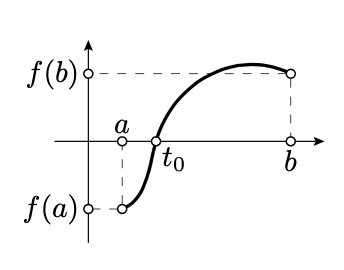3.2: Teorema del Valor Intermedio
- Page ID
- 114420
Dejar\(f: [a, b] \to \mathbb{R}\) ser una función continua. Asumir\(f(a)\) y\(f(b)\) tener signos opuestos, entonces\(f(t_0) = 0\) para algunos\(t_0 \in [a,b]\).

Se supone que el teorema del valor intermedio es conocido; debe ser cubierto en cualquier curso de cálculo. Usaremos solo el siguiente corolario:
Supongamos que para cualquiera\(t \in [0, 1]\) tenemos tres puntos en el plano\(O_t\),\(A_t\), y\(B_t\), tal que
- Cada función\(t \mapsto O_t\),\(t \mapsto A_t\), y\(t \mapsto B_t\) es continua.
- Para cualquiera\(t \in [0, 1]\), los puntos\(O_t, A_t\), y\(B_t\) no se encuentran en una línea. Entonces\(\angle A_0 O_0 B_0\) y\(\angle A_1 O_1 B_1\) tener la misma señal.
- Prueba
-
Considera la función\(f(t) = \measuredangle A_tO_tB_t\).
Dado que los puntos\(O_t, A_t\), y\(B_t\) no se alinean en una línea, el Teorema 2.4.1 implica que\(f(t) = \measuredangle A_tO_tB_t \ne 0\) ni\(\pi\) para ninguna\(t \in [0, 1]\).
Por lo tanto, por Axioma IIIc y Ejercicio 1.9.2,\(f\) es una función continua. Por el teorema del valor intermedio,\(f(0)\) y\(f(1)\) tienen el mismo signo; de ahí sigue el resultado.


